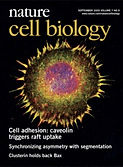Integrin dependent regulation of Ral isoforms and function in cells.
Having established the presence of Ral-Arf6 crosstalk downstream of integrin and oncogenic Ras we asking how this crosstalk helps mediated delivery of exocytic vesicles at the plasma membrane and its role in other Ral dependent cellular functions. We are also interested in the role Ral effectors (beyond RalBP1) have in mediating this crosstalk and Ral dependent signalling. We are also evaluating how RalGEFs, GAPs and Aurora kinase A contribute to adhesion and oncogenic Ras-dependent Ral activation and function.
PUBLICATIONS
• Arf6 and microtubule regulate adhesion-dependent trafficking of lipid rafts. N. Balasubramanian, D. Scott, M., J. E. Casanova, Castle D, M. A. Schwartz. (2007). Nature Cell Biology. Volume 9 No 12. 1381-91. Click Here.
• The RalA - exocyst complex regulates integrin-dependent membrane raft localization and anchorage dependent growth signaling. N. Balasubramanian*, J. Meier, D. Scott, M., M.A. White, M. A. Schwartz. (2009). Current Biology. 2010 Jan 12;20(1):75-9. Click Here.
• Ral-Arf6 crosstalk regulates Ral dependent exocyst trafficking and anchorage independent growth signalling. Archana Pawar, Jeremy A. Meier, Anwesha Dasgupta, Neha Diwanji, Neha Deshpande, Kritika Saxena, Natasha Buwa, Siddhi Inchanalkar, Martin Alexander Schwartz, Nagaraj Balasubramanian*. Cellular Signalling. Volume 28, Issue 9, September 2016, Pages 1225–1236. Click Here.
• REVIEW - Integrin-Dependent Regulation of Small GTPases: Role in Cell Migration . Archana Pawar and Nagaraj Balasubramanian*. J Indian Inst Sci (Feb 2017). doi:10.1007/s41745-016-0010-4. Link. Click Here.
• Adhesion-growth factor crosstalk regulates AURKB activation and ERK signalling in re-adherent fibroblasts. Siddhi Inchanalkar & Nagaraj Balasubramanian. Journal of Biosciences volume 46, Article number: 46 (2021).

Integrin signalling at focal adhesions in adherent cells.
If you are a school student or non-science person and are curious about why we study the matrix and what it does

FIBULIN - Extracellular Matrix protein regulating EGFR function in lung cancers.
Epidermal Growth Factor Receptor (EGFR) is a known promoter of tumor progression and is overexpressed in lung cancers. Growth factor receptors (including EGFR) are known to interact with extracellular matrix (ECM) proteins, which regulates their activation and function. Fibulin-1 (FBLN1) is a major component of the ECM in lung tissue, and its levels are known to be downregulated in non-small cell lung cancers (NSCLC). Together, these findings show FBLN1C/1D, as part of the ECM, can bind and regulate EGFR activation and function. They further highlight the role tumor ECM composition could have in influencing EGFR dependent lung cancers.
PUBLICATIONS
• Cell Derived Matrix Fibulin-1 Associates With Epidermal Growth Factor Receptor to Inhibit Its Activation, Localization and Function in Lung Cancer Calu-1 Cells. Keerthi Harikrishnan*, Omkar Joshi, Saili Madangirikar and Nagaraj Balasubramanian*. Front. Cell Dev. Biol., 03 July 2020
Adhesion dependent regulation of organelle architecture and function.
These studies are focused on understanding the possible role integrin-mediated adhesion could have in regulating organelle architecture and function. Our studies have revealed such regulatory crosstalk between integrins and the Golgi, mediated through Arf1. Understanding how adhesion differentially regulates Tran vs Cis/Cis-medial Golgi is another important focus for the lab. We are studying how this could deregulate the Golgi signatures in normal cells and its implications in cancers. We are also interested in understanding how this regulation could translate to other cellular organelles and the implications this has in cellular function.
PUBLICATIONS
• Cell-matrix adhesion controls Golgi organization and function through Arf1 activation in anchorage-dependent cells. Vibha Singh, Chaitanya Erady and Nagaraj Balasubramanian*. Journal of Cell Science (2018) 131.

Golgi in nonadherent cells
• Kinetics of Arf1 inactivation regulates Golgi organisation and function in non-adherent fibroblasts. Biology Open. (2023). Rajeshwari B R, Nikita Shah, Prachi Joshi, M S Madhusudan, Nagaraj Balasubramanian*.
• Cell-surface glycans are quantitative reporters of Golgi dysfunction in single cells. Prachi Joshi, Aashish Satyajith, Debiprasad Panda, BR Rajeshwari, Mukund Thattai*, Nagaraj Balasubramanian*. bioRxiv. (manuscript in review)

A first-hand account of the work by Vibha as part of the JCS First Person series. Vibha is now an active Prelighter for JCS
A first-hand account of the work by Rajeshwari as part of the Biology Open First Person series.


Antara’s winning image ‘Breaking symmetry’ is the cover image for Journal of Cell Science’s Special Issue: Imaging Cell Architecture and Dynamics;

Drug nanovesicle uptake in
cancer cells
Role of AURKA-Ral crosstalk. Nanovesicle mediated delivery of AURKA inhibitor MLN8237.
We are interested in understanding the AURKA-RalA crosstalk and the role it could have downstream of adhesion and oncogenic Ras. In collaboration with Dr. Jayakannan’s lab (IISER - Chem) we have developed and tested self-assembling dextran nanovesicles a novel drug delivery systems for delivering poorly soluble drugs specifically to cancer cells. We have tested these to deliver the AURKA inhibitor MLN8237, improving the cancer cell uptake and specificity of the drug. Our studies use VMLN to target AURKA and RalA downstream, making it a useful tool to target RalA. VMLN is also proving to be an effective tool to specifically inhibit AURKA evaluating its role in cellular function.
PUBLICATIONS
• Polymer Nanovesicle-Mediated Delivery of MLN8237 Preferentially Inhibits Aurora Kinase A To Target RalA and Anchorage-Independent Growth in Breast Cancer Cells. Siddhi Inchanalkar†, Nilesh Umakant Deshpande‡, Vishakha Kasherwal, Manickam Jayakannan and Nagaraj Balasubramanian. Mol. Pharmaceutics, 2018,1583046-3059.
• Polysaccharide Nano-vesicular Multidrug Carrier for Synergistic Killing of Cancer Cells . P. S. Pramod#, Ruchira Shah#, Sonali Chapekar, Nagaraj Balasubramanian* and M. Jayakannan*. (# equal contributors) - Nanoscale, 2014,6, 11841-11855. Click Here.
• Dextran Vesicular Carriers for Dual Encapsulation of Hydrophilic and Hydrophobic Molecules and Delivery into Cells. Pramod, P.; Takamura, Kathryn; Chaphekar, Sonali; Balasubramanian,N* ; Jayakannan, M*. Biomacromolecules. 2012, 13 (11), pp 3627–3640. Click Here.
-
Adhesion-growth factor crosstalk regulates AURKB activation and ERK signalling in re-adherent fibroblasts.
Journal of Biosciences volume 46, Article number: 46 (2021). Siddhi Inchanalkar & Nagaraj Balasubramanian.
Click Here.
Listen to a PODCAST
on the work and its
implications recorded
for THE HINDU
Click to listen
Adhesion dependent regulation of caveolar endocytosis.
Our work aims to study the role and regulation of caveolar endocytosis by adhesion, focusing on the role tyrosine-14 phosphorylation of caveolin-1 has in and out of caveolae. We are also interested in understanding the role tyrosine phosphates could have in mediating this regulation, particularly in caveolin-1 expressing cancers.
PUBLICATIONS
• Caveolin1 Tyrosine-14 Phosphorylation: Role in Cellular Responsiveness to Mechanical Cues. Natasha Buwa, Debasmita Mazumdar & Nagaraj Balasubramanian. The Journal of Membrane Biology (2020). Click Here.
• Adhesion‐dependent Caveolin1 Tyrosine‐14 phosphorylation is regulated by FAK in response to changing matrix stiffness. Natasha Buwa, Nivedhika Kannan, Shaunak Kanade & Nagaraj Balasubramanian. FEBS Letters ( Dec 2020). Click Here. (NEW)
• Phospho-Caveolin-1 Mediates Integrin-Regulated Membrane Domain Internalization. M.A.del Pozo, N. Balasubramanian, N. B. Alderson, W. B. Kiosses, A. Grande, R.G.W. Anderson and M. A. Schwartz. (2005). Nature Cell Biology. 7(9):901-8. Click Here.
• Integrin-mediated adhesion regulates membrane order. K. Gaus K, S. Le Lay, N. Balasubramanian, M. A. Schwartz. (2006) . J Cell Biol. 174(5):725-34 (Highlight). Click Here.




Adhesion dependent regulation of trafficking and organelle function in 2D vs 3D microenvironments.
Cells in 3D microenvironments look and behave distinctly different from cells replated on 2D glass. the mechanosensitive nature Integrin-mediated adhesion and signalling is seen to help respond to changing matrix stiffness in 2D and 3D microenvironments. We are particularly interested in understanding how trafficking and organelle function is regulated in response to changing matrix stiffness. The role caveolae play in ths mechano-responsiveness of cells and the implications of this regulation in cancers are what the lab is studying. We are also using our expertise in cellular imaging in 3D to understand the behaviour of cells in context of implants in 3D microenvironments.



















